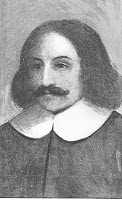ENG 48A
Journal #21 The First Americans
December 7, 2009

"When he [the good mind] had made the universe he was in doubt respecting some being to possess the Great Island; and he formed two images of the dust of the ground in his own likeness, male and female, and by his breathing into their nostrils he gave them the living souls, and named them Ea-gwe-howe, i.e., a real people; and he gave the Great Island all the animals of game for their maintenance and he appointed thunder to water the earth by frequent rains, agreeable of the nature of the system; after this the Island became fruitful and vegetation afforded the animals subsistence." (The Iroquois Creation Story 20)
"Though David Cusick was one of the first Iroquois to record the oral literature of his nation in the alphabetic writing of Western civilization, contemporary Iroquois do not necessarily receive his work with praise. For instance, Seneca-Wyandot scholar Barbara A. Mann points out that Cusick inserted missionary interpretations of Iroquois creation stories into the text of his Sketches of Ancient History of the Six Nations." (From Finding a place for David Cusick in Native American literary history - Susan Kalter)
The above quote is from David Cusick's rendition of the Iroquois Creation Story at the part where the "good mind" creates humans, and the world as we know it to be. It also relates how the "good mind" gave rein to the humans to have control over the world that he created.

I was struck initially by the marked similarities between the Iroquois Creation Story and the Genesis of the Bible. The parallels are so unmistakable that passages between the two could be easily interchanged. God breathes upon Adam to give him life; the "good mind" does that too. God gave humans free rein of the earth and its living things; again the "good mind" did the very same thing. Even the fall of mankind is subtly hinted in the later parts of the story, where the "evil mind" was deemed to be responsible for the creation of reptiles.
The question remains now is that whether David Cusick, as suggested by Susan Kalter, inserted Christian interpret ations of the myth and presented it to us modern readers in that fashion. Such undertakings are not completely of in history. For instance, there was a similar issue with Beowulf, where messages with Christianity connotations were inserted throughout the poem to the point that some question whether the poem was constructed by more than a single poet, or whether it was modified later by other individuals with the agenda to spread Christianity. It would be indeed be interesting to obtain the copy of the original myth for comparison to see how Cusick made modifications, if any, to the contents.
ations of the myth and presented it to us modern readers in that fashion. Such undertakings are not completely of in history. For instance, there was a similar issue with Beowulf, where messages with Christianity connotations were inserted throughout the poem to the point that some question whether the poem was constructed by more than a single poet, or whether it was modified later by other individuals with the agenda to spread Christianity. It would be indeed be interesting to obtain the copy of the original myth for comparison to see how Cusick made modifications, if any, to the contents.
 ations of the myth and presented it to us modern readers in that fashion. Such undertakings are not completely of in history. For instance, there was a similar issue with Beowulf, where messages with Christianity connotations were inserted throughout the poem to the point that some question whether the poem was constructed by more than a single poet, or whether it was modified later by other individuals with the agenda to spread Christianity. It would be indeed be interesting to obtain the copy of the original myth for comparison to see how Cusick made modifications, if any, to the contents.
ations of the myth and presented it to us modern readers in that fashion. Such undertakings are not completely of in history. For instance, there was a similar issue with Beowulf, where messages with Christianity connotations were inserted throughout the poem to the point that some question whether the poem was constructed by more than a single poet, or whether it was modified later by other individuals with the agenda to spread Christianity. It would be indeed be interesting to obtain the copy of the original myth for comparison to see how Cusick made modifications, if any, to the contents.


















